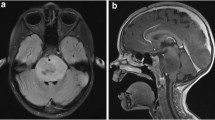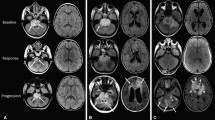Abstract
Children with diffuse intrinsic pontine glioma (DIPG) need new and more efficient treatments. They can be developed at relapse or at diagnosis, but therefore they must be combined with radiotherapy. Survival of children after recurrence and its predictors were studied to inform the possibility to design early phase clinical trials for DIPG at this stage. Among 142 DIPG patients treated between 1998 and 2014, 114 had biopsy-proven DIPG with histone H3 status available for 83. We defined as long survivors’ patients who survived more than 3 months after relapse which corresponds to the minimal life expectancy requested for phase I/II trials. Factors influencing post-relapse survival were accordingly compared between short and long-term survivors after relapse. Fifty-seven percent of patients were considered long survivors and 70% of them had a Lansky Play Scale (LPS) above 50% at relapse. Patients who became steroids-independent after initial treatment for at least 2 months had better survival after relapse (3.7 versus 2.6 months, p = 0.001). LPS above 50% at relapse was correlated with better survival after relapse (3.8 versus 1.8 months, p < 0.001). Patients with H3.1 mutation survived longer after relapse (4.9 versus 2.7 months, p = 0.007). Patients who received a second radiotherapy at the time of relapse had an improved survival (7.5 versus 4 months, p = 0.001). In the two-way ANOVA analysis, steroid-independence and LPS predicted survival best and the type of histone H3 (H3.1 or H3.3) mutated did not improve prediction. Survival of many DIPG patients after relapse over 3 months would make possible to propose specific trials for this condition. Steroid-independence, H3 mutation status and LPS should be considered to predict eligibility.



Similar content being viewed by others
References
Vanan MI, Eisenstat DD (2015) DIPG in children: what can we learn from the past? Front Oncol 5:237
Puget S, Beccaria K, Blauwblomme T, Roujeau T, James S, Grill J, Zerah M, Varlet P, Sainte-Rose C (2015) Biopsy in a series of 130 pediatric diffuse intrinsic pontine gliomas. Child’s Nerv Syst 31:1773–1780
Kieran MW (2015) Time to rethink the unthinkable: upfront biopsy of children with newly diagnosed diffuse intrinsic pontine glioma (DIPG). Pediatr Blood Cancer 62(1):3–4
Kieran MW, Goumnerova LC, Prados M, Gupta N (2016) Biopsy for diffuse intrinsic pontine glioma: a reappraisal. J Neurosurg Pediatr 18:390–391
Walker DA, Liu J, Kieran M, Jabado N, Picton S, Packer R, St. Rose C (2013) A multi-disciplinary consensus statement concerning surgical approaches to low-grade, high-grade astrocytomas and diffuse intrinsic pontine gliomas in childhood (CPN Paris 2011) using the Delphi method. Neuro Oncol 15:462–468
Louis DN, Perry A, Reifenberger G, von Deimling A, Figarella-Branger D, Cavenee WK, Ohgaki H, Wiestler OD, Kleihues P, Ellison DW (2016) The 2016 World Health Organization classification of tumors of the central nervous system: a summary. Acta Neuropathol 131:803–820
Frappaz D, Schell M, Thiesse P et al (2008) Preradiation chemotherapy may improve survival in pediatric diffuse intrinsic brainstem gliomas: final results of BSG 98 prospective trial. Neuro Oncol 10:599–607
Warren KE (2012) Diffuse intrinsic pontine glioma: poised for progress. Front Oncol 2:205
Jansen MH, Van Zanten SEV, Aliaga ES et al (2015) Survival prediction model of children with diffuse intrinsic pontine glioma based on clinical and radiological criteria. Neuro Oncol 17:160–166
Massimino M, Biassoni V, Miceli R et al (2014) Results of nimotuzumab and vinorelbine, radiation and re-irradiation for diffuse pontine glioma in childhood. J Neurooncol 118:305–312
Castel D, Philippe C, Calmon R et al (2015) Histone H3F3A and HIST1H3B K27M mutations define two subgroups of diffuse intrinsic pontine gliomas with different prognosis and phenotypes. Acta Neuropathol 130:815–827
Steffen-Smith EA, Baker EH, Venzon D, Shandilya S, Bent RS, Warren KE (2014) Measurements of the pons as a biomarker of progression for pediatric DIPG. J Neurooncol 116:127–133
Dhermain FG, Hau P, Lanfermann H, Jacobs AH, van den Bent MJ (2010) Advanced MRI and PET imaging for assessment of treatment response in patients with gliomas. Lancet Neurol 9:906–920
Chassot A, Canale S, Varlet P et al (2012) Radiotherapy with concurrent and adjuvant temozolomide in children with newly diagnosed diffuse intrinsic pontine glioma. J Neurooncol 106:399–407
Geoerger B, Hargrave D, Thomas F et al (2011) Innovative therapies for children with cancer pediatric phase I study of erlotinib in brainstem glioma and relapsing/refractory brain tumors. Neuro Oncol 13:109–118
Bernier-Chastagner V, Grill J, Doz F et al (2005) Topotecan as a radiosensitizer in the treatment of children with malignant diffuse brainstem gliomas: Results of a French Society of Paediatric Oncology Phase II Study. Cancer 104:2792–2797
Stupp R et al (2014) Cilengitide combined with standard treatment for patients with newly diagnosed glioblastoma with methylated MGMT promoter (CENTRIC EORTC 26071–22072 study): a multicentre, randomised, open-label, phase 3 trial. Lancet Oncol 15:1100–1108
Dufour C et al (2006) High-grade glioma in children under 5 years of age: a chemotherapy only approach with the BBSFOP protocol. Eur J Cancer 42(17):2939–2945 42:2939–2945
Hargrave D, Bartels U, Bouffet E (2006) Diffuse brainstem glioma in children: critical review of clinical trials. Lancet Oncol 7:241–248
Cohen KJ, Jabado N, Grill J (2017) Diffuse intrinsic pontine gliomas—current management and new biologic insights. Is there a glimmer of hope? Neuro Oncol 19:1025–1034
Wolff JE, Rytting ME, Vats TS, Zage PE, Ater JL, Woo S, Kuttesch J, Ketonen L, Mahajan A (2012) Treatment of recurrent diffuse intrinsic pontine glioma: the MD Anderson Cancer Center experience. J Neurooncol 106:391–397
Green AL, Kieran MW (2015) Pediatric brainstem gliomas: new understanding leads to potential new treatments for two very different tumors. Curr Oncol Rep. https://doi.org/10.1007/s11912-014-0436-7
Janssens GO, Gandola L, Bolle S et al (2017) Survival benefit for patients with diffuse intrinsic pontine glioma (DIPG) undergoing re-irradiation at first progression: a matched-cohort analysis on behalf of the SIOP-E-HGG/DIPG working group. Eur J Cancer 73:38–47
Carceller F, Fowkes LA, Khabra K et al (2016) Pseudoprogression in children, adolescents and young adults with non-brainstem high grade glioma and diffuse intrinsic pontine glioma. J Neurooncol 129:109–121
Acknowledgements
We thank the Swedish Children Cancer Foundation for supporting Dr Giraud fellowship in Gustave Roussy Cancer Campus, Marianne Raquin for her precious help with the databases, All the patients and the medical crew who made possible the documentation of medical history.
Author information
Authors and Affiliations
Corresponding author
Electronic supplementary material
Below is the link to the electronic supplementary material.
Rights and permissions
About this article
Cite this article
Lobon-Iglesias, M.J., Giraud, G., Castel, D. et al. Diffuse intrinsic pontine gliomas (DIPG) at recurrence: is there a window to test new therapies in some patients?. J Neurooncol 137, 111–118 (2018). https://doi.org/10.1007/s11060-017-2702-7
Received:
Accepted:
Published:
Issue Date:
DOI: https://doi.org/10.1007/s11060-017-2702-7




